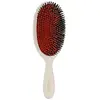Mason Pearson Popular Bristle & Nylon Hairbrush BN1 Versus Sachi Skin Ursolic Acid and Retinal Overnight Reform Serum
What's inside
What's inside
 Key Ingredients
Key Ingredients

No key ingredients
 Benefits
Benefits

No benefits
 Concerns
Concerns

No concerns
 Ingredients Side-by-side
Ingredients Side-by-side

Water
Skin ConditioningNiacinamide
SmoothingGlycerin
HumectantPentylene Glycol
Skin ConditioningSilybum Marianum Seed Oil
Skin ConditioningCucumis Sativus Seed Oil
EmollientHydrogenated Starch Hydrolysate
HumectantSodium Hyaluronate
HumectantUrsolic Acid
MaskingRetinal 0.05%
Skin ConditioningGlutathione
Bakuchiol
AntimicrobialPalmitoyl Tripeptide-38
Skin ConditioningPhospholipids
Skin ConditioningSuperoxide Dismutase
AntioxidantNigella Sativa Seed Oil
EmollientRosa Rubiginosa Seed Oil
EmollientRubus Chamaemorus Seed Oil
Skin ConditioningDaucus Carota Sativa Root Extract
Skin ConditioningOcimum Sanctum Leaf Extract
Skin ConditioningAvena Sativa Kernel Oil
Skin ConditioningZingiber Officinale Root Extract
MaskingHelianthus Annuus Seed Oil
EmollientBisabolol
MaskingLactobacillus Ferment
Skin ConditioningRosmarinus Officinalis Leaf Extract
AntimicrobialLonicera Caprifolium Flower Extract
PerfumingHonokiol
AntioxidantMagnolol
AntioxidantTocopherol
AntioxidantDimethyl Isosorbide
SolventCyclodextrin
AbsorbentArachidyl Alcohol
EmollientGlyceryl Caprylate
EmollientBehenyl Alcohol
EmollientAcrylates/C10-30 Alkyl Acrylate Crosspolymer
Emulsion StabilisingTocopheryl Acetate
AntioxidantButylene Glycol
HumectantArachidyl Glucoside
EmulsifyingPolyglyceryl-6 Laurate
EmulsifyingCaprylhydroxamic Acid
Polyglyceryl-10 Oleate
Skin ConditioningSodium Hydroxide
BufferingSorbitan Palmitate
EmulsifyingHydroxypropyl Cyclodextrin
MaskingGlucose
HumectantCitric Acid
BufferingLonicera Japonica Flower Extract
Skin ConditioningPotassium Sorbate
PreservativeSodium Benzoate
MaskingWater, Niacinamide, Glycerin, Pentylene Glycol, Silybum Marianum Seed Oil, Cucumis Sativus Seed Oil, Hydrogenated Starch Hydrolysate, Sodium Hyaluronate, Ursolic Acid, Retinal 0.05%, Glutathione, Bakuchiol, Palmitoyl Tripeptide-38, Phospholipids, Superoxide Dismutase, Nigella Sativa Seed Oil, Rosa Rubiginosa Seed Oil, Rubus Chamaemorus Seed Oil, Daucus Carota Sativa Root Extract, Ocimum Sanctum Leaf Extract, Avena Sativa Kernel Oil, Zingiber Officinale Root Extract, Helianthus Annuus Seed Oil, Bisabolol, Lactobacillus Ferment, Rosmarinus Officinalis Leaf Extract, Lonicera Caprifolium Flower Extract, Honokiol, Magnolol, Tocopherol, Dimethyl Isosorbide, Cyclodextrin, Arachidyl Alcohol, Glyceryl Caprylate, Behenyl Alcohol, Acrylates/C10-30 Alkyl Acrylate Crosspolymer, Tocopheryl Acetate, Butylene Glycol, Arachidyl Glucoside, Polyglyceryl-6 Laurate, Caprylhydroxamic Acid, Polyglyceryl-10 Oleate, Sodium Hydroxide, Sorbitan Palmitate, Hydroxypropyl Cyclodextrin, Glucose, Citric Acid, Lonicera Japonica Flower Extract, Potassium Sorbate, Sodium Benzoate